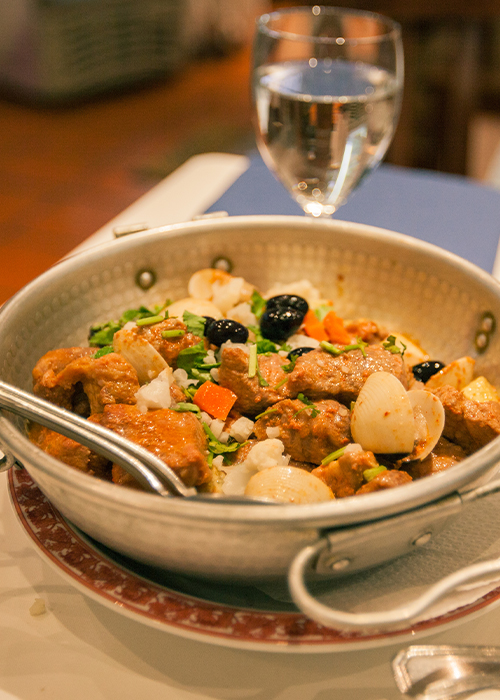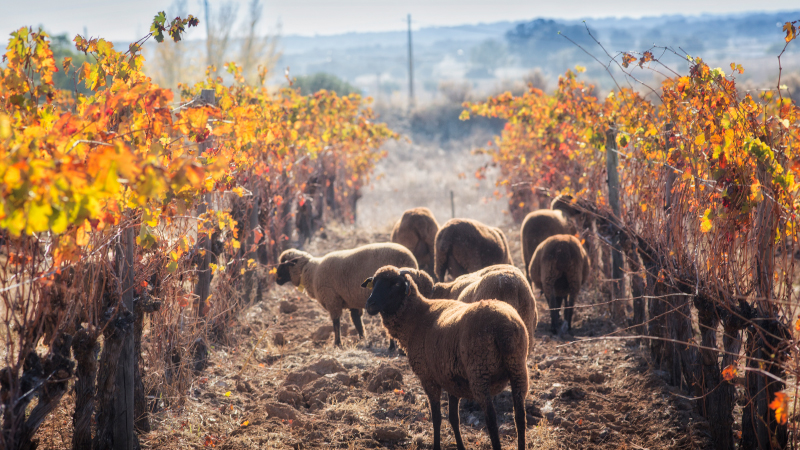
With its distinct and diverse growing areas, hundreds of native grape varieties, each often known by a plethora of names, and an ancient vinous heritage, Portugal’s laid-back Alentejo region is a wine explorer’s paradise. Sunny, safe, surprisingly affordable, and accessible (a quick and easy 30-minute drive east of Lisbon), Alentejo offers the wine-savvy traveler authentic experiences far from the crowds. At around the same size as Massachusetts, Alentejo (pronounced ah-len-TAY-zhoo) has much to satisfy lovers of the arts, history, and the outdoors and, especially, food and wine. Everything is within easy driving distance, and rush hour is non-existent. There’s something for everyone in the Alentejo!
Portugal’s largest and least populous region is bounded by the Tejo River to the north (Alentejo means Beyond the Tejo), flowing east to west and on into the Atlantic at Lisbon. On its southern border lies the coastal Algarve. Blessed with over 3,000 hours of sunshine annually, similar to San Diego and well above Portugal’s national average, Alentejo routinely accounts for the highest summertime temperatures in all Europe. When it comes to wine, vineyard plantings at 56,500 acres are somewhat more than Napa’s 45,000 acres and about the same as Washington state.
Alentejo and its UNESCO World Heritage capital, the beautiful city of Évora, remain off-the-beaten-path and a connoisseur’s treasure. But in the context of wine, what sets Alentejo apart?
With a wine-growing tradition dating back over 2,000 years, it can confidently be said that the Portuguese know a thing or two about wine. So, the fact that Alentejo is a source of one in every three bottles of wine consumed in Portugal, speaks volumes.
Alentejo vineyards thrive in the most varied soils of any region in Portugal, from clay and limestone to quartz and schist, resulting in velvety, robust reds and mesmerizing whites. The Alentejo wine list is long on complex whites and singular, compelling reds, including crisp, elegant white Arinto and light-bodied red Castelão, as well as Trincadeira, with its intoxicating aromas of blackberries and florals, to name a few of the region’s more prominent native grapes. Alentejo also hosts international varieties, such as Chardonnay and Cabernet Sauvignon, plus Mediterranean classics like Carignan and Tempranillo (better known in Alentejo as “Aragonez.”) Boasting award-winning quality, Alentejo has received global acclaim for over-delivering at all price points, whether it’s a special-occasion bottle or a festive by-the-glass pour.
A LEGACY OF EXCELLENCE
Winemaking in Portugal dates to the Romans, and it is they who are credited with introducing the technique of maturing wine in amphorae, or large clay vessels called talhas de barro. Today, Alentejo is one of only two regions worldwide where the ancient tradition of fermenting and storing wine in clay pots has continued, uninterrupted, for over 2,000 years.
ENJOYING THE FLAVORS OF ALENTEJO
Long called “the breadbasket of Portugal,” Alentejo, with its hot, dry climate — ideal for grain production — has led to a culinary culture that perfectly complements its wines. And each of the eight sub-regions of Alentejo has its unique flavors.
When it comes to Alentejo reds, Trincadeira is the oldest and most widely planted variety. Given that Trincadeira demands a hot, dry climate, this should come as no great surprise. Rich, full-bodied Trincadeira is dominant in Alentejo’s northernmost Portalegre sub-zone, prized for its ability to amplify pigmentation in blends (blended wines enjoy a long tradition in Alentejo and throughout Portugal), and for its lovely, nuanced aromas. Trincadeira and Trincadeira-based blends are ideal for pairing with presunto (cured ham), nutty, flavorful cheeses, and Atlantic-raised cod and halibut.
On the steep inclines of the Serra de São Mamede hills, also in Portalegre, higher altitudes and lower temperatures yield fresh, elegant whites from the Antão Vaz variety. Antão Vaz, vinified in various food-flexible styles ranging from crisp, firmly structured whites all the way to smooth oak-aged blends, is rooted in notes of citrus peel and almond — excellent with tapas, citrus-accented chicken dishes, and pear- and cherry-based desserts.
In the southern part of the Alentejo, the sub-zones of Granja Amareleja and Moura have arid, dry summers, resulting in the Moreto grape’s early ripening. The distinct climate produces silky, smooth wines, particularly spicy reds ideal for serving with steak, roasts, and Alentejo’s famous porco preto (black pork). Vidigueira, with its milder climate, boasting cool air that flows off the sapphire Algarve coast, nurtures grapes in rich volcanic soil of granite and schist, producing the plummy depth of Tinta Grossa, a perfect pairing for vegetable-based side dishes, lamb, and roast chicken. And the Serra da Ossa, a mighty mountain range in the Redondo sub-zone, protects vines from harsh winds; its diverse soil produces succulent reds ideal for enhancing dishes such as red pepper-marinated pork, clams with garlic, and seafood paella.
SEEING RED
Alentejo is known for its reds, with Alicante Bouschet an established star amid the crowd of over 250 indigenous varieties, plus a few well-known international players, including Cabernet Sauvignon. A French crossing of Petit Bouschet and Grenache (1886), it was introduced to the Alentejo over 100 years ago. Today, this most Portuguese non-Portuguese variety is Alentejo’s flagship red and often assumed to be native! Noted for its structure and firmness (Alentejo’s winemakers have learnt how to tame those tannins!), the grape also retains its acidity – a big plus in this dry climate. Locals nickname it Tinta de Escrever (“writing ink”) for its inky-red wines.
Also prized is Alfrocheiro, with blackberry and strawberry notes, and medium-bodied Castelão, dripping with hints of juicy red currants and fleshy fruit. Both are excellent pairings for holiday season turkey and tart desserts. Touriga Nacional, a common blending grape in Port wines, but with the aging potential of Cabernet Sauvignon, enjoys the deep aroma of floral, berries, and bergamot, perfect with a sharp, festive cheese platter, a side dish of cruciferous vegetables, or cranberry-topped stuffing.
A WHITE APART
Alentejo also boasts aromatic whites, the region’s non-calcareous, schist-derived soils producing vines that ripen slowly and wines with a vibrant structure. Surprisingly, given the region’s record-breaking temperatures, one-fifth of Alentejo wine production is from white cultivars. Popular is the Fernão Pires, its muscat-like taste enhanced by peppery notes, citrus fruit, and orange blossom. The Roupeiro variety is beloved for its aromatic, joyful crispness, stone fruit and melon notes, and nutty character. Verdelho, with its aromatic honeysuckle notes and full body, ranging from fresh and fruity to rich and buttery when aged, evolves into deep flavors of nectarines and ripe apricots. Then there’s Arinto, its refreshing, light-hearted aromas of green apple and citrus. mixed with super-high acidity and mineral notes, ideal for enjoying with pastries and fruit tarts.
VINHO MADE THE NATURAL WAY
The Alentejo, a Noah’s Ark of flora and fauna thanks to low population density and a diverse landscape, contains a hot and arid climate that makes embracing sustainability a necessity. Green growing techniques include creating nature protection areas, conserving scarce water resources, and limiting chemical use (the region’s climate naturally reduces the need for pesticides). Healthy soil is also celebrated, with vineyards utilizing compost, often from upcycled stalks, grape seeds, and olive leaves, to produce a more biodiverse top layer. The Alentejo, which accounts for over one-third of the world’s cork forests, has also sustainably bottled wine for centuries, capping each label with a tiny piece of its history.
In recent years, the Wines of Alentejo Sustainability Program (WASP) has been at the vanguard of sustainability in Portugal, providing a certification seal to qualifying wineries, signifying the highest level of viticulture, vinification, and social responsibility. In little over five years, Wines of Alentejo’s award-winning Sustainability Program (WASP) has established the region as one of the world’s most progressive when it comes to sustainability. Qualifying wineries must comply with 86 percent or more of 171 demanding WASP criteria, including cutting back on electricity and water consumption by 20-30 percent. Members represent nearly 50 percent of Alentejo’s vineyard area and include all Alentejo’s principal players.
“Strong interest from local wineries and their ability to meet the tough requirements are indicative of the Alentejo region’s deep-seated commitment to sustainability,” says WASP sustainability coordinator João Barroso, an environmental engineer. “An admirer once told me that Alentejo is a small region doing the work of giants.”
“From the start, we were able to show that even small producers can adopt sustainable practices and save money in the process,” Barroso continues. “Sustainability is not a marketing ploy. It’s a necessity and the new paradigm for responsible business in the twenty-first century.”
RETAILERS
While it may be hard to hop on a plane to Portugal this holiday season, you can still pick up a bottle from Alentejo at your local wine shop. On the East Coast, swing by Warehouse Wine & Spirits (New York), Heritage of Sherborn (Massachusetts), Urban Grape (Boston), or Grand Cata (Washington DC). In the Midwest, wander up to BottlesUp! (Chicago) or The Vineyard Wine Shop (Denver), and on the West Coast, the taste of Southern Portugal is as easy as a drive to Ferry Plaza Wine Merchant (San Francisco) or The Wine House (Los Angeles).
This article is sponsored by Wines of Alentejo.






